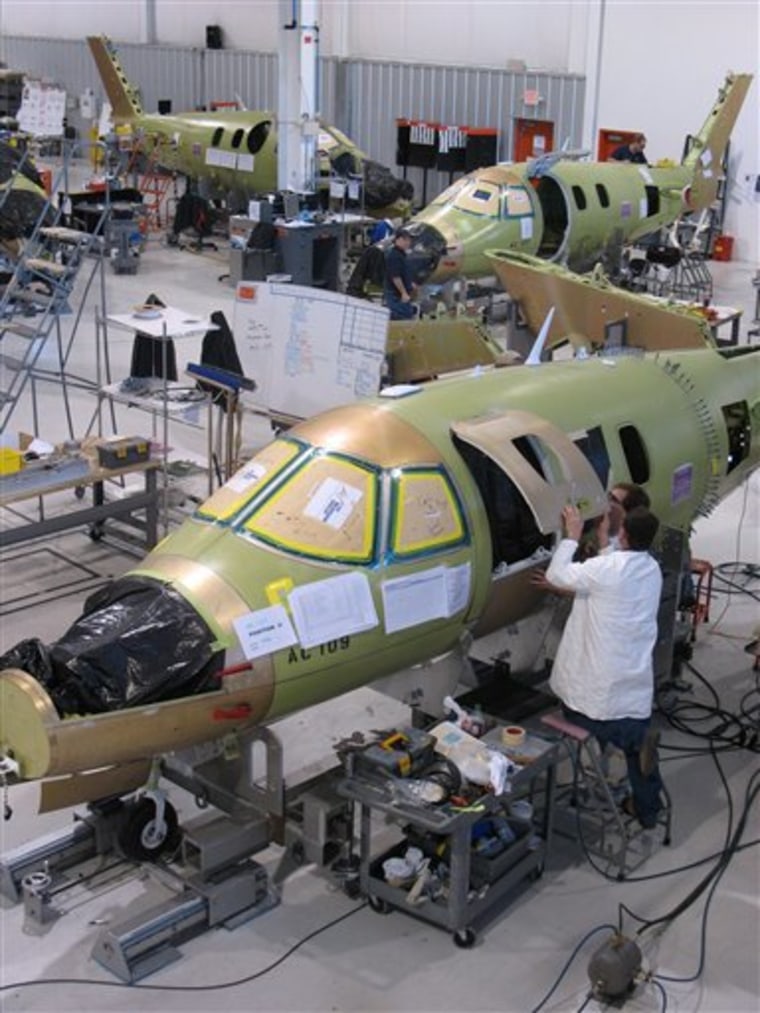Eclipse Aviation's critics say it was too good to be true: A twin-engine, six-seat jet for a mere $775,000, or about a quarter of the price of competitors' jets in 2000.
A decade later, the Albuquerque manufacturer of the Eclipse 500 faces a federal bankruptcy judge in Delaware who will decide whether the company will be liquidated in Chapter 7 proceedings.
The company has said it has no plans to fight the bankruptcy, which comes before a court Wednesday.
"Especially for the last three to four months, it's been a process that's akin to watching a loved one die," said Vern Raburn, the former Microsoft executive who founded Eclipse and served until last summer as its chief executive. "You're always hopeful there'll be a remission. You're hopeful there will be a miracle cure."
Eclipse's current chief executive, Roel Pieper, did not return telephone calls seeking comment.
Eclipse supporters rave about the jet, touting its fuel efficiency and safety, and say Eclipse helped create a market segment of very light jets, or VLJs, which are twin-engine jets with five or six seats that have been likened to SUVs with wings.
In 2006, the National Aeronautic Association awarded Eclipse the 2005 Robert J. Collier Trophy for innovation and the advancement of general aviation for its production of very light jets.
"The whole concept of a VLJ, the whole market segment, anybody who claims that Eclipse doesn't get credit for that, they're just smoking dope," Raburn told The Associated Press in a telephone interview last week.
Raburn said what sunk Eclipse was "gross mismanagement" of the company's inventory, which ate up cash, and its inability to finish the aircraft. For example, the jets lack equipment that allows them to fly in wintry weather.
Raburn said Eclipse also started taking on debt before aircraft production could support the company. He estimated the company lost about $1 billion.
Aviation industry analysts started predicting Eclipse's demise last fall.
They said Eclipse's business model relied on a high-volume production strategy to support the jet's low price tag, which jumped to $2.1 million last summer in what many believe was an effort that came too late to make the company financially viable.
In 2002, Eclipse said it planned to produce 1,000 jets a year, but it struggled with suppliers and a nearly three-year delay in getting Federal Aviation Administration certification. In the end, 260 jets were built.
Eclipse canceled contracts with suppliers of the engine and avionics system, which cost the company about $300 million, Raburn said. Eclipse also was sued by the manufacturer of the jet's tailpiece in late 2007, causing more delays.
Raburn said aviation industry suppliers prevented Eclipse from producing aircraft as quickly as it would have liked.
"One of the big mistakes that I made was assuming that the aerospace supply chain could function in the way that all other supply chains in the world can function," Raburn said. "It's fraught with fraud and dishonesty. It has massive inefficiencies."
But Doug Royce, an aerospace analyst for Connecticut-based Forecast International Inc., which had forecast last fall that Eclipse's production would end this year, said other aviation companies have been successful with those same suppliers.
"Other companies manage to deal with the suppliers he's dealing with and make it to production," Royce said.
Royce said he thinks Eclipse suffered from being overly ambitious in promoting a new way of building an airplane, which attracted a lot of nay-sayers who focused their criticism on Raburn.
"The promises for what he could deliver didn't match reality," Royce said.
Although Raburn talked of why the company failed, he acknowledges that he, too, is to blame.
"I don't want to come across in any way, shape, form or fashion that it's not my fault. We failed," Raburn said. "But we also accomplished an awful lot."
Mike McConnell, who has touted Eclipse's successes for years as vice president of marketing and sales, said the company should be credited with starting the very light jet market segment.
"We proved that there was a market for smaller low-priced jets and today there are three versions out there — the Eclipse, the (Cessna) Mustang and Embraer," McConnell said.
Not so, says J. Mac McClellan, editor in chief of Flying Magazine and a pilot who has flown the Eclipse. He said the disagreement comes down to the definition of very light jets.
McClellan, who's been a pilot for 37 years, said Eclipse's maximum takeoff weight under 6,000 pounds puts it in a different category from the Mustang and Embraer's Phenom 100.
"A long list of companies announced Eclipse-style VLJs several years ago, but all are long gone," he wrote in an e-mail.
He described the jet he flew as having "conventional" flying qualities, but with poor brakes and incomplete avionics.
"The legacy of Eclipse was its ability to raise money and sell hope," McClellan wrote. "To me Eclipse proved again that the dream of cheap aircraft is powerful and if you say you can build an airplane for a third, or at least less than half, of what it really costs, people want to believe and will give you money."
Last week, senior secured noteholders requested that Eclipse's Chapter 11 restructuring proceed to bankruptcy when Pieper failed to come through with financing to buy the company.
Several companies are considering how to keep the Eclipse 500s flying and mulling continuing production of new aircraft.
Bill Herp, president and CEO of Concord, Mass.-based Linnear Air, said he's investigating forming a company called Eclipse Services and Support LLC that would service current Eclipse jets.
Herp said he hopes once the current national financial turmoil has passed, production of the jet will restart.
"This is an airplane worth saving," he said.
